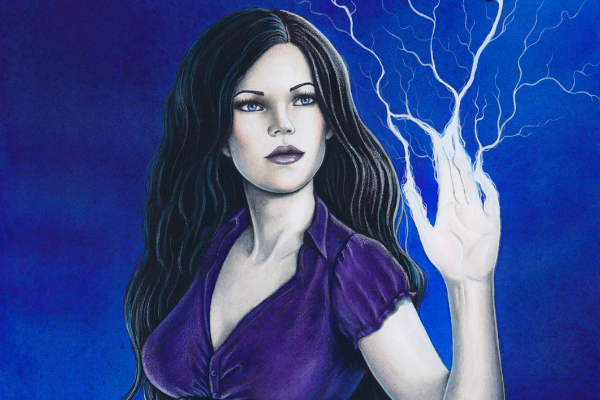Blueprint or Blindfold? How I Write a Book

“The creative process is a process of surrender, not control.” — Julia Cameron
Let me tell you a secret—not a deep, dark one, but the kind I usually keep between myself and my desk chair.
After writing my first series, The Telepathic Clans, I had this wild thought: Maybe I should get serious. You know, do it “right.” Like the real bestselling authors do. The ones with charts, bulletproof outlines, and whiteboards covered in sticky notes arranged like a crime scene. Their process looked so... official. So clean.
So I gave it a try.
I plotted. I outlined. I followed all the rules. I mapped out an entire series before I wrote a single scene. And then I sat down to write, fully expecting to feel brilliant and efficient and wildly productive.
Instead, I felt... flat.
The words came, but they didn’t sparkle. The characters did what I told them, but they had no edge, no voice of their own. It was like I’d invited them to a dinner party and handed them cue cards instead of letting them speak. I finished two whole books that way—fully plotted, fully written, and fully... meh.
They’re still sitting in a folder on my computer. I like to call it the dungeon. It’s not locked, but I rarely open the door.
That was the moment I realized something important: I’m not a planner. I’m not built for clean lines and three-act structures taped to the wall. I’m a pantser—and yes, that’s a real term. It comes from “flying by the seat of your pants,” which is exactly what it sounds like. No roadmap. No flight plan. Just instinct, stubbornness, and the faith that something will catch me if I jump.
Writing that way might look chaotic from the outside—and sometimes it is—but that’s where the heart is. That’s where the surprise lives. And surprise, I’ve learned, is everything.
So no, I don’t plot. I follow. I listen. I chase sparks and shadows. And I never again try to write the “right” way.
Because for me, the real magic only happens when I let go.

Every Story Starts with a Character
“She wasn't looking for a knight. She was looking for a sword.” — Atticus
For me, every book begins when a character pops into my head. Not a whole plot or even a setting—just a single vivid person who won’t leave me alone. My very first character, Brenna from The Telepathic Clans, was exactly like that. She was so vivid, in fact, that I ordered a professional portrait of her. It became my first book cover and my online avatar; it's still hanging on my wall at home—a treasured reminder of how this whole crazy adventure started.
The same thing happened with Libby from Chameleon Assassin—her story began with a vague idea of someone who could blend into any environment. It wasn't until I let go of planning that she became a fully formed assassin with a heart and mind of her own. Similarly, Erin from Rosie O'Grady's Paranormal Bar and Grill came to life as I wrote her, growing more nuanced and complex with every scene.
These strong, vibrant women—all urban fantasy heroines—aren’t built from outlines. They grow organically, revealing their truths to me over time. I’m always as eager as readers are to discover who they’ll become.
And they never arrive quietly.
Kellana, from Dark Streets, stepped into my imagination like smoke—quiet, watchful, and hard to pin down. She didn’t demand the spotlight. She just stood there, with her secrets and her shadows, and waited for me to notice her strength. Writing her felt like chasing whispers down alleys. Everything unfolded slowly, but nothing was accidental.
Danica James, from The Rift Chronicles, was all edges. The kind of woman who doesn’t wait to be handed power—she takes it. There was no soft entry with Danica. She brought her scars, her fury, and a mind sharper than any weapon. I never tried to tame her. I just followed.
And now there’s Katy Brown, my latest heroine from A Spirit Mage’s Journey. Katy didn’t start out knowing she had power—her life taught her to hide, to survive, to track instead of lead. But the more I wrote, the more I saw what she was becoming: not a chosen one, not a savior—but a girl who refused to break, even when the world kept trying to crush her. Her strength isn’t loud, but it’s deep. And it matters.
None of these women came to me fully formed. They unfolded—one thought, one reaction, one refusal at a time. I didn’t build them. I met them. I listened.
And once they show up, they don’t leave. They live in my head, in my home, in the bones of the books I write. They are the heartbeat of every story.
And honestly? I wouldn’t have it any other way.

Learning from Writers I Admire
"If you don’t have time to read, you don’t have the time (or the tools) to write." — Stephen King
It’s a strange kind of relief when you realize the writers you’ve admired for years are also figuring things out as they go.
When I stumbled across Stephen King’s description of writing as excavation—uncovering a story like a fossil already buried in the ground—I felt something loosen in my chest. It made so much sense. That’s what writing often feels like to me. I don’t create stories—I find them, buried somewhere just beneath the surface of a character’s voice.
Margaret Atwood has spoken candidly about not knowing how her novels will end when she starts writing them. Not pretending. Not performing certainty. Just sitting down and seeing what the story reveals. That honesty stayed with me. She gave language to something I’d always felt but didn’t know I was allowed to trust.
And Raymond Chandler? He wrote entire detective novels without knowing whodunnit until the end. He focused on character and mood first—structure came later. His stories are full of atmosphere and grit and decisions made in the moment. They live because they were allowed to evolve naturally.
Hearing those admissions from writers I respect gave me more than reassurance. They made me feel like I belonged. That the messy, uncertain, sometimes sideways way I write isn’t broken. It’s just mine.
There’s no single right way to write. Some authors need outlines; others need silence, and space, and the freedom to follow a thread into the dark. I’ve learned that I’m not alone in this. There’s a whole lineage of writers out there—some wildly successful—who trust the unfolding just like I do.
And when I feel lost, that thought helps me keep going. I’m not the only one who writes without a map. I’m just one more voice, listening for the next piece of the story to reveal itself.
Navigating Challenges
"You can only see as far as your headlights, but you can make the whole trip that way." — E.L. Doctorow
Writing without a roadmap can sometimes mean getting lost. There are days when I sit at my desk, staring at the screen, thinking, "Where do I go from here?" Characters can be stubborn—they sometimes lead me into tangled plots or impossible situations. That happened with Elf’s Tears, originally intended as a full novel called Realm Sliders. After finishing a first draft, feedback showed me it needed more depth. Stepping back, I allowed myself to rewrite it entirely, transforming it into something shorter and far more meaningful.
When stuck, I remind myself that it's okay not to know the answers immediately. I'll walk away from my desk, take long walks, or sometimes write conversations between characters that I know won't end up in the book. Often, these seemingly pointless explorations unlock new ideas and paths forward.
It turns out writer's block is less about being stuck and more about needing space to find the right path. And that’s perfectly fine—I'm still learning.

The Joy of Writing Without a Map
"No surprise in the writer, no surprise in the reader." — Robert Frost
The beauty of my approach is that I’m constantly surprised. Readers often praise the intricate, clever plots of my books, believing they must be meticulously planned. The truth is far simpler: the characters drive everything, naturally creating complexity and depth that surprise even me.
Writing this way is like an ongoing conversation with imaginary friends. I never fully know where we'll end up, but I trust it'll be somewhere worth going. Every day at my desk feels fresh, filled with anticipation rather than obligation. I'm not just telling a story—I'm discovering it alongside my readers.
So here’s my confession, dear readers: I’m not as organized as you might think, but I promise the journey is genuine, heartfelt, and endlessly surprising. I’m still learning, growing, and discovering—and I'm grateful you're on this adventure with me.


